Papers by Manjula Marella
Disability and rehabilitation, Feb 20, 2024

Patient Education and Counseling, Feb 1, 2015
To investigate the effectiveness of a low vision self-management programme (LVSMP) in older adult... more To investigate the effectiveness of a low vision self-management programme (LVSMP) in older adults. Participants (n=153) were existing clients of a national low vision rehabilitation organisation randomly allocated to usual services (n=60) or usual services plus LVSMP (n=93). The LVSMP was an 8-week group programme facilitated by low vision counsellors. The primary outcome was vision-specific quality of life (QoL) measured using the Impact of Vision Impairment (IVI) questionnaire. Secondary outcomes emotional well-being, self-efficacy and adaptation to vision loss were measured using the depression, anxiety, stress scale (DASS), general self-efficacy scale (GSES), and short form adaptation to age-related vision loss scale (AVL12). At one and six month follow-up assessments, no significant between-group differences were found for vision-specific QoL, emotional well-being, adaptation to vision loss or self-efficacy (p>0.05). Univariate and multivariate analyses revealed no impact of the intervention on outcome measures. In contrast to previous work, our study found limited benefit of a LVSM programme on QoL for older adults accessing low vision services. When implementing self-management programmes in low vision rehabilitation settings, issues of client interest, divergence of need, programme accessibility and fidelity of intervention delivery need to be addressed.

© 2011 Dr. Manjula MarellaCommunity-based rehabilitation (CBR) services were introduced to improv... more © 2011 Dr. Manjula MarellaCommunity-based rehabilitation (CBR) services were introduced to improve coverage, equity and participation in daily living for people with disabilities (PWD). Since the inception of CBR, there have been several changes in models of service delivery. The initial ones focussed primarily on improving the physical function of PWDs. The recent model, recommended in the World Health Organisation’s (WHO) CBR Guidelines, includes a holistic approach to promote inclusion, economic independence and education of PWDs. There is an immense need of CBR for people with vision impairment because of the poor coverage of services. Paradoxically, even though approximately 90% of people with vision impairment live in resource-poor settings, most of the vision rehabilitation services are institution-based and located in major cities and towns. However, the effectiveness of CBR programs, particularly those related to people with vision impairment is not well understood, primarily because there are no published evaluations conducted on the vision-related CBR programs. While there is literature on CBR programs other than vision impairment, these are mainly descriptions of services. In order to promote a greater adoption of vision-related CBR programs, there is a need to empirically demonstrate the effectiveness of different models. This thesis addresses this need by developing an evaluation framework for vision-related CBR programs, namely the Centre for Eye Research Australia (CERA)-CBR Framework (CCF). This research was conducted in three phases. First, a literature review was conducted to obtain indicators needed to evaluate CBR programs, which were grouped into themes, key areas and components of the CCF using grounded theory. Second, the CCF was reviewed by an expert panel for content validity. Finally, it was field-tested in two different vision-related CBR programs in Fiji and Cambodia to investigate the utility of the indicators in the field using two specific criteria: applicability and measurability. An indicator was considered applicable if it was relevant in determining the strengths and limitations of a CBR program and measurable if it provided qualitative or quantifiable information. The CCF comprises four components namely “service delivery system,” “program management,” “networks” and “outcomes”; 21 key areas; and 230 indicators. “Service delivery system” includes three key areas: ‘availability,’ ‘utilisation’ and ‘quality’ of services; “program management” has five key areas: ‘program planning,’ ‘human resources,’ ‘infrastructure,’ ‘coverage’ and ‘sustainability’; “networks” contained five key areas: ‘linkages,’ ‘referrals,’ ‘advocacy’ and ‘support from families’ and ‘support from communities’; and “outcomes” had eight key areas: ‘intended outcomes,’ ‘functional independence,’ ‘psycho-social wellbeing,’ ‘education,’ ‘economic independence,’ ‘empowerment,’ ‘changes in community’ and ‘satisfaction with services.’ Of the initial 230 indicators, 201 (87%) and 219 (95%) were shown to be applicable to identify the strengths and limitations of CBR programs in Fiji and Cambodia respectively. Of these, 167 (83%) and 178 (81%) were measurable in Fiji and Cambodia respectively. Across both countries 197 (85%) indicators were applicable and of these 156 (79%) were measurable. The CCF was useful to understand the strengths and limitations of the two CBR programs and provide recommendations to improve the services. This research has made an important contribution towards initiating empirical research to evaluate and compare vision-related CBR programs. It has provided the first structured and practical tool to evaluate such programs. The majority of the proposed indicators were applicable and measurable in Fiji and Cambodia indicating its potential as a useful and practical evaluation tool for use in CBR programs
Investigative Ophthalmology & Visual Science, 2010
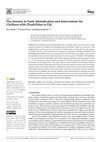
International Journal of Environmental Research and Public Health
Early identification of developmental delay or disability and access to early intervention improv... more Early identification of developmental delay or disability and access to early intervention improves outcomes for children with disabilities and their families. However, in many low- and middle-income countries, services and systems to enable timely, co-ordinated care and support are lacking. The aim of this research was to explore the experiences of families of children with developmental disabilities in Fiji in accessing services for intervention and support across sectors. This qualitative study involved conducting interviews with caregivers of children with disabilities (n = 12), and relevant key stakeholders from health, education, disability, and social support sectors (n = 17). We used journey maps to identify key stages of the families’ journeys, identify key barriers and enablers at each stage, and provide multi-sectoral recommendations for each stage. Enablers include proactive help seeking behaviours, the use of informal support networks and an increasingly supportive poli...
The Journal of Laryngology & Otology

Global Public Health, 2022
People living in low- and middle- income countries (LMICs) meet significant challenges in accessi... more People living in low- and middle- income countries (LMICs) meet significant challenges in accessing ear and hearing care (EHC) services. We conducted a scoping review to identify and summarise such barriers, to recognise gaps in the literature, and to identify potential solutions. Reviewers independently screened titles, abstracts and full-text articles and charted data. We undertook thematic analysis of supply and demand side dimensions of access, and summarised findings mapped against the Levesque framework. Of 3048 articles screened, 62 met inclusion criteria for review. Across the five access dimensions, supply-side constraints were more frequently described, the most common being a shortage of EHC workforce or appropriate facilities, despite high demand. We identified a thin geographical spread of literature on barriers to accessing EHC services in LMICs, reflecting low availability of such services. LMICs face a diverse range of demand and supply side challenges including workforce, equipment and resource shortages, and challenges for the majority of the population to pay for such services. There is a need for many LMICs to develop health policy and programmes in EHC, including integration into primary care, scaling up the EHC workforce through increased training and education, and improving EHC literacy through public health measures.
The relative impact of vision impairment and cardiovascular disease on quality of life: the
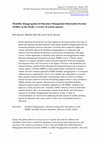
Knowledge Management for Development Journal, 2016
Pacific Island governments have to report against an increasing number and range of global and re... more Pacific Island governments have to report against an increasing number and range of global and regional education indicators that require disability-disaggregated data for monitoring disability-inclusive education. Given the effort required to adapt data systems and build capacity for disability disaggregation, it is imperative that indicators provide optimal information to inform policy and planning. This paper reviews current approaches to disability data collection and disaggregation within Education Management Information Systems (EMISs) across 14 Pacific Island countries. It compares disability-related education indicators from the Sustainable Development Goals, the Convention on the Rights of Persons with Disabilities, the Incheon Strategy, and the Pacific Education Development Framework in relation to current capacity of Pacific EMISs to report against these. Amongst the countries studied, the most common approach to EMIS disability disaggregation is to categorise children ba...
Investigative Ophthalmology & Visual Science, 2011
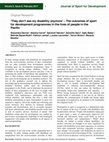
In many settings, people with disabilities are marginalised from the socio-economic activities of... more In many settings, people with disabilities are marginalised from the socio-economic activities of their communities and are often excluded from development activities, including sport for development programmes. Sport is recognised as having unique attributes, which can contribute to the development process and play a role in promoting the health of individuals and populations. Yet there is little evidence, which demonstrates whether and how sport for development can be disability-inclusive. The aim of this qualitative research was to address this knowledge gap by documenting the enablers and barriers to disability inclusion within sport for development programmes in the Pacific, and to determine the perceived impact of these programmes on the lives of people with disability. Qualitative interviews and one FGD were conducted with implementers, participants with and without disability, and families that have a child with disability participating in sport. Participation in sport was r...
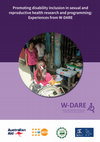
Research background: Throughout the W-DARE project, women with disabilities and Disabled People’s... more Research background: Throughout the W-DARE project, women with disabilities and Disabled People’s Organisations (DPOs) were involved across research activities in a range of roles; including as decision-makers, co-researchers, disability experts, program facilitators and participants. There are a range of established benefits to actively engaging people with disabilities as researchers and research partners, and participatory research approaches that support and enable the participation of women with disabilities, are widely viewed as effective and appropriate ways of involving women with disabilities in research. However, actively engaging women with disabilities as decision-makers and members of the research team is a relatively unique approach in many places. This could be due to negative assumptions about the capacity of women with disabilities to conduct research, as well as a lack of knowledge and awareness amongst researchers and policy-makers about why they should engage wom...
Investigative Ophthalmology & Visual Science, 2009
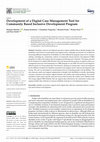
International Journal of Environmental Research and Public Health, 2021
Disability inclusive development practices require reliable data to identify people with disabili... more Disability inclusive development practices require reliable data to identify people with disabilities, their barriers to participation and support needs. Although several tools are available for measuring different components of disability, it is often difficult for program teams in low resource settings, including lay community workers of community based inclusive development (CBID) programs, to collect and analyze data for program monitoring and evaluation. This paper presents the development of a digital CBID Modular Tool with automated data analysis to support routine case management processes and monitoring of a CBID program in Laos PDR. The tool was developed in different phases involving stakeholder consultations, auditing of existing tools, content development for the different modules for disability assessment and support needs, software development and testing. The tool was developed in a participatory process including people with disabilities. The tool measures needs and...



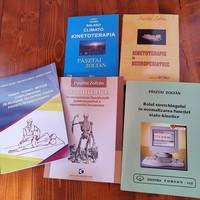






Uploads
Papers by Manjula Marella